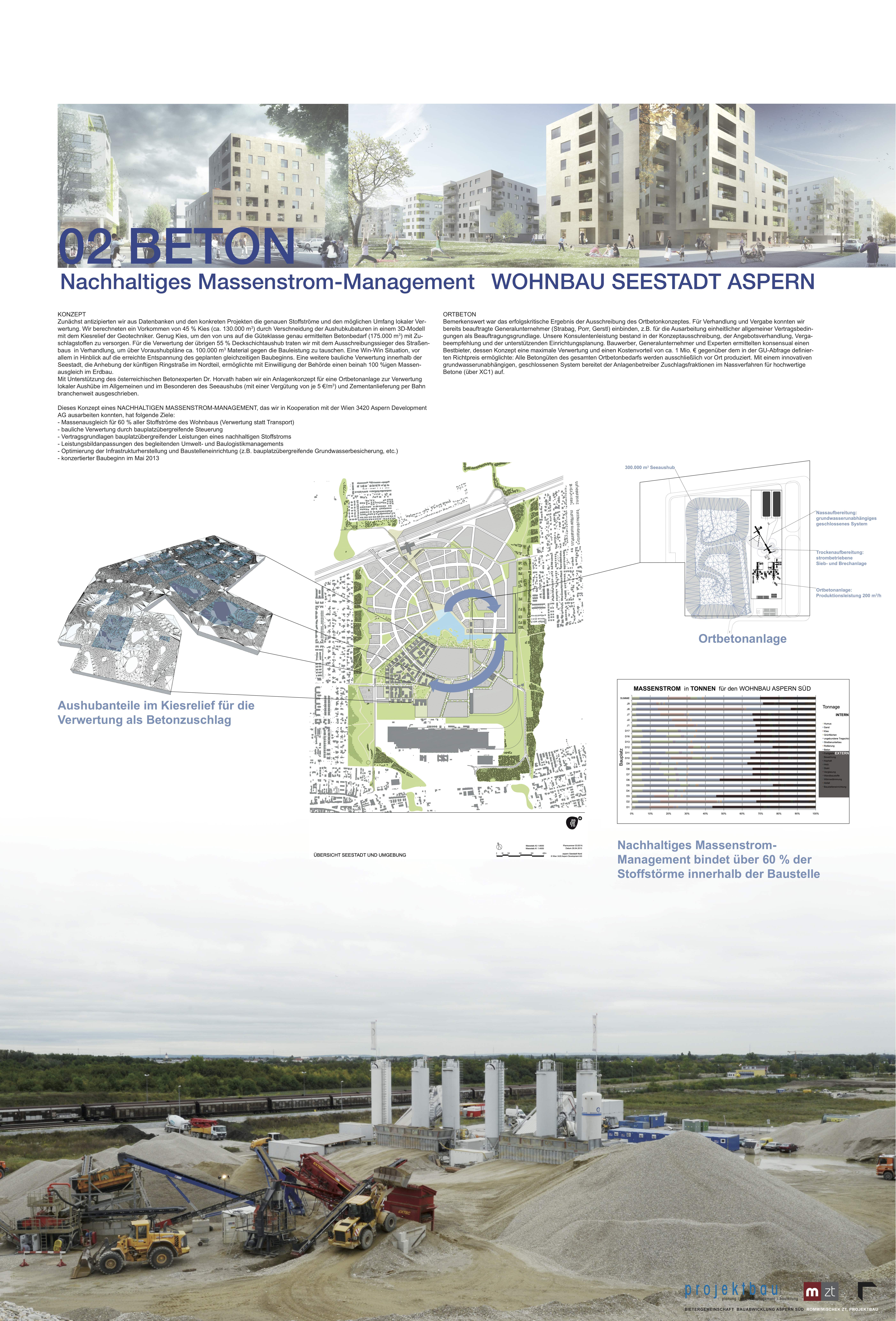Seestadt Aspern
Seestadt Aspern is an urban expansion project of Vienna within the city's boundaries, with a lake at its heart, located only 15 minutes by subway from the city centre.
The residential building in the Seestadt Süd (south side of the city project), supervised by forschen planen bauen, recycles 1 million tonnes of material from its own construction activities. A cleverly devised logistics system between the building sites ensures that almost the entire excavated earth is used directly on site. The in-situ concrete plant erected there processes the gravel from the lake excavation and the excavation pits. Civil engineering uses local sand gravel from preceding excavations for road dams, frost boxes and paved surfaces. This material extraction also shortens the construction time of the residential building. A special track was laid in the new construction logistics centre for the delivery of cement by rail.
With this environmentally friendly construction process, the construction of the residential building saves more than 100,000 heavy-duty truck trips in the city area. A piece of the city - a total of half the annual volume of residential construction in Vienna - can thus be built in a shorter time with less environmental impact through the use of local resources.
REALIZATION
We were able to implement all these measures through agreements between the 20 construction companies in 9 workshops with tenders and contracts for construction services that spanned all construction sites. The central instrument was an increase/decrease in costs service list, which specifically supports the general contractor assignment for the construction site. Reduced costs from the mass compensation resulting from the short procedure in earthworks, the remuneration of gravel excavation and the joint transfer of the in-situ concrete plant are offset by additional costs from the requirements of construction logistics and environmental management. In addition, we had to contractually anchor complex models for cost sharing in joint commissions, such as the constructional recycling of the Nordring, which is to be accompanied by waste management and geotechnical measures, among the building applicants.
SUSTAINABLE MASS FLOW MANAGEMENT in figures (m3 loose):
100,000 m3 of preceding excavation material are used to construct the road dams
150,000 m3 of excavated material used for terrain modelling on the Nordring
50,000 m3 of excavated material serve as aggregate in the in-situ concrete plant
300,000 m3 lake excavation serve as aggregate in the in-situ concrete plant
CONCEPT
Initially, we anticipated the exact material flows and the possible scope of local recycling from databases and concrete projects. We calculated an occurrence of 45 % gravel (approx. 130,000 m3) by intersecting the excavated cubatures in a 3D model with the gravel relief of the geotechnical engineers. Enough gravel to supply the demand of concrete (175,000 m3) with aggregates that we have precisely determined for the quality class. For the recycling of the remaining 55 % surface course excavation, we entered into negotiations with the winner of the tender for road construction in order to exchange approx. 100,000 m3 of material for the construction work using preceding excavation plans. A win-win situation, especially regarding the relaxation achieved in the planned simultaneous start of construction. A further structural utilisation within the Urban Lakeside, the raising of the future Nordring, made it possible, with the approval of the authorities, to achieve almost 100 % mass compensation in earthworks.
With the support of the Austrian concrete expert Dr. Horvath, we tendered a plant concept for a cast-in-place concrete plant for the recycling of local excavations in general and in particular the sea excavation (with a remuneration of 5 €/m3 each) and cement delivery by rail throughout the industry.
This concept of a SUSTAINABLE MASS FLOW MANAGEMENT, which we were able to develop in cooperation with Wien 3420 Aspern Development AG, has the following objectives:
- mass balancing for 60 % of all material flows in residential construction (recycling instead of transport)
- structural utilization through control across all construction sites
- contractual basis for cross-site services of a sustainable material flow
- performance profile adjustments of the accompanying environmental and construction logistics management
- optimisation of infrastructure construction and construction site equipment (e.g. groundwater protection across construction sites, etc.)
- concerted start of construction in May 2013
LOCAL CONCRETE
The success-critical result of the tender for the in-situ concrete concept was remarkable. For the negotiation and awarding of the contract, we were able to involve already commissioned general contractors (Strabag, Porr, Gerstl), e.g. for the elaboration of uniform general contractual conditions as a basis for the commissioning. Our consulting services consisted of the tendering of the concept, the tender negotiation, the award recommendation and the supporting planning of the furnishing. Building contractors, general contractors and experts consensually determined the best bidder, whose concept enabled a maximum utilisation and a cost advantage of approx. 1 million € compared to the target price defined in the general contractor query: All concrete qualities of the entire in-situ concrete requirement are produced exclusively on site. With an innovative groundwater-independent, closed system, the plant operator processes aggregate fractions in a wet process for high-quality concretes (via XC1).
The project was nominated for the State Prize for Engineering Consulting in 2013.

